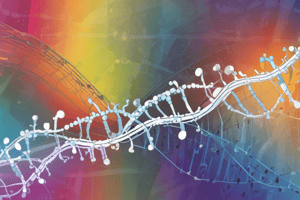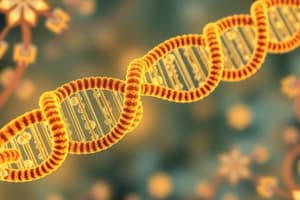Podcast
Questions and Answers
What occurs when body temperature rises in homeotherms?
What occurs when body temperature rises in homeotherms?
- Piloerection
- Shivering
- Vasoconstriction
- Sweat production (correct)
Which of the following is a mechanism that the body uses to retain heat when temperatures fall?
Which of the following is a mechanism that the body uses to retain heat when temperatures fall?
- Piloerection (correct)
- Sweat production
- Vasodilation
- Puffing
What role does the hypothalamus play in thermoregulation?
What role does the hypothalamus play in thermoregulation?
- It is responsible for vasoconstriction.
- It produces insulin and glucagon.
- It directly cools the body by evaporation.
- It acts as the control center for body temperature. (correct)
What is the primary function of sweat glands during high temperatures?
What is the primary function of sweat glands during high temperatures?
What action is primarily responsible for increasing blood flow to the skin's surface during cooling?
What action is primarily responsible for increasing blood flow to the skin's surface during cooling?
Which homeostatic mechanism is involved in regulating blood glucose concentration?
Which homeostatic mechanism is involved in regulating blood glucose concentration?
What behavior might a homeotherm exhibit to help regulate body temperature in response to cooler environmental conditions?
What behavior might a homeotherm exhibit to help regulate body temperature in response to cooler environmental conditions?
Which of the following describes the relationship between muscle activity and body temperature regulation?
Which of the following describes the relationship between muscle activity and body temperature regulation?
What is the primary purpose of the methylated guanine cap added to mRNA?
What is the primary purpose of the methylated guanine cap added to mRNA?
During translation, what role does tRNA play in protein synthesis?
During translation, what role does tRNA play in protein synthesis?
Which process involves the removal of non-coding sequences from mRNA?
Which process involves the removal of non-coding sequences from mRNA?
What is the sequence of three bases in mRNA that specifies an amino acid called?
What is the sequence of three bases in mRNA that specifies an amino acid called?
Which of the following statements about RNA interference (RNAi) is correct?
Which of the following statements about RNA interference (RNAi) is correct?
Who is recognized for establishing the foundational principles of inheritance?
Who is recognized for establishing the foundational principles of inheritance?
What is the role of the poly-A tail added to mRNA?
What is the role of the poly-A tail added to mRNA?
Which method allows genetic information to flow from RNA back to DNA?
Which method allows genetic information to flow from RNA back to DNA?
What effect does insulin have on blood glucose levels?
What effect does insulin have on blood glucose levels?
Which hormone is secreted by the alpha cells of the pancreas?
Which hormone is secreted by the alpha cells of the pancreas?
What primarily differentiates Type I and Type II diabetes?
What primarily differentiates Type I and Type II diabetes?
What is a key characteristic of Type I diabetes?
What is a key characteristic of Type I diabetes?
Which process is stimulated by glucagon to increase blood glucose levels?
Which process is stimulated by glucagon to increase blood glucose levels?
Which system regulates blood pressure and fluid balance in the body?
Which system regulates blood pressure and fluid balance in the body?
After consuming a meal, which hormone is released to lower blood glucose levels?
After consuming a meal, which hormone is released to lower blood glucose levels?
What is a potential cause of Type II diabetes?
What is a potential cause of Type II diabetes?
What initiates the release of renin from the renal juxtaglomerular apparatus?
What initiates the release of renin from the renal juxtaglomerular apparatus?
Where does the conversion of angiotensin I to angiotensin II primarily occur?
Where does the conversion of angiotensin I to angiotensin II primarily occur?
Which of the following effects does angiotensin II NOT have?
Which of the following effects does angiotensin II NOT have?
How do ACE inhibitors impact blood pressure?
How do ACE inhibitors impact blood pressure?
What is one of the side effects of ACE inhibitors?
What is one of the side effects of ACE inhibitors?
In chronic kidney disease, ACE inhibitors help manage which of the following?
In chronic kidney disease, ACE inhibitors help manage which of the following?
What does evolutionary biology primarily study?
What does evolutionary biology primarily study?
Which mechanism is NOT a part of the evolution process described in evolutionary biology?
Which mechanism is NOT a part of the evolution process described in evolutionary biology?
What foundational concept in evolutionary biology was proposed by Charles Darwin and Alfred Russel Wallace?
What foundational concept in evolutionary biology was proposed by Charles Darwin and Alfred Russel Wallace?
What does 'descent with modification' imply in the context of evolution?
What does 'descent with modification' imply in the context of evolution?
What role do mutations play in the process of evolution?
What role do mutations play in the process of evolution?
How does gene flow affect a population?
How does gene flow affect a population?
Which mechanism of evolution can cause significant changes in a small population by chance?
Which mechanism of evolution can cause significant changes in a small population by chance?
What observation did Darwin make about the finches in the Galápagos Islands?
What observation did Darwin make about the finches in the Galápagos Islands?
What has genetic sequencing of ancient DNA revealed about Neanderthals?
What has genetic sequencing of ancient DNA revealed about Neanderthals?
Which of the following mechanisms is NOT a driving force of evolution?
Which of the following mechanisms is NOT a driving force of evolution?
Flashcards are hidden until you start studying
Study Notes
Genetic Processes and Protein Synthesis
- Capping: A methylated guanine cap protects the mRNA during its synthesis.
- Polyadenylation: A poly-A tail is added to enhance mRNA stability and protect it from degradation.
- Splicing: Non-coding introns are removed while coding exons are joined to form mature mRNA, which is ready for translation.
- mRNA Function: Transports genetic information from the nucleus to cytoplasm where it directs protein synthesis at ribosomes.
- Translation Mechanism: The ribosome reads mRNA codons, each corresponding to a specific amino acid, facilitating protein assembly.
- tRNA Role: Transfer RNA carries amino acids to the ribosome, pairing anticodons with mRNA codons, while elongating the polypeptide chain.
Genetic Information Flow
- Reverse Transcription: Retroviruses like HIV create new DNA from RNA, showcasing alternative genetic information flow.
- Non-Coding RNAs: Transcribed RNA molecules that do not translate into proteins but play essential roles in regulating cellular functions.
- RNA Interference (RNAi): Mechanism using double-stranded RNA to silence specific genes, integral to gene regulation in various organisms.
Classical Genetics and Inheritance
- Mendelian Genetics: Gregor Mendel's cross-breeding of pea plants established foundational inheritance principles known as Mendel's laws.
Homeostasis and Thermoregulation
- Homeostasis: Mechanisms oppose changes in internal conditions to maintain equilibrium, utilizing negative feedback loops.
- Body Temperature Control:
- Hypothalamus: Acts as a control center detecting temperature changes.
- Vasodilation: Skin blood vessels dilate to cool the body when temperature rises.
- Shivering: Muscle contractions occur to generate heat when body temperature drops.
- Piloerection: Hair standing on end in response to cold, trapping warm air.
- Behavioral Responses: Actions like bathing or burrowing aid in temperature regulation.
Blood Glucose Regulation
- Insulin and Glucagon: Antagonistic hormones secreted by the pancreas to regulate blood glucose levels.
- Insulin: Released when glucose levels rise, promoting glycogen synthesis and glucose uptake.
- Glucagon: Released when glucose levels drop, stimulating glycogen breakdown to elevate glucose concentration.
- Diabetes Types:
- Type I Diabetes (IDDM): Autoimmune destruction of beta cells leading to insulin deficiency; requires insulin injections.
- Type II Diabetes (NIDDM): Decreased sensitivity to insulin; often managed through diet and lifestyle changes.
Renin-Angiotensin-Aldosterone System (RAAS)
- RAAS: Regulates blood pressure and fluid balance via renin, angiotensin II, and aldosterone.
- Renin Release: Triggered by low sodium levels and decreased blood flow, leading to angiotensin I production.
- Angiotensin II Effects: Causes vasoconstriction, stimulates thirst, and promotes aldosterone release for sodium reabsorption.
Evolutionary Biology
- Theory of Evolution: Charles Darwin and Alfred Russel Wallace’s concept explaining species adaptation through natural selection.
- Descent with Modification: Species evolve from common ancestors, a principle illustrated by Darwin's finches in the Galápagos Islands.
- Key Evolutionary Mechanisms:
- Mutation: Source of genetic variation essential for evolution.
- Gene Flow: Transfer of genes between populations increases genetic diversity, exemplified by the interbreeding of ancient humans and Neanderthals.
- Genetic Drift: Random changes in genes within small populations leading to evolutionary shifts.
Studying That Suits You
Use AI to generate personalized quizzes and flashcards to suit your learning preferences.




